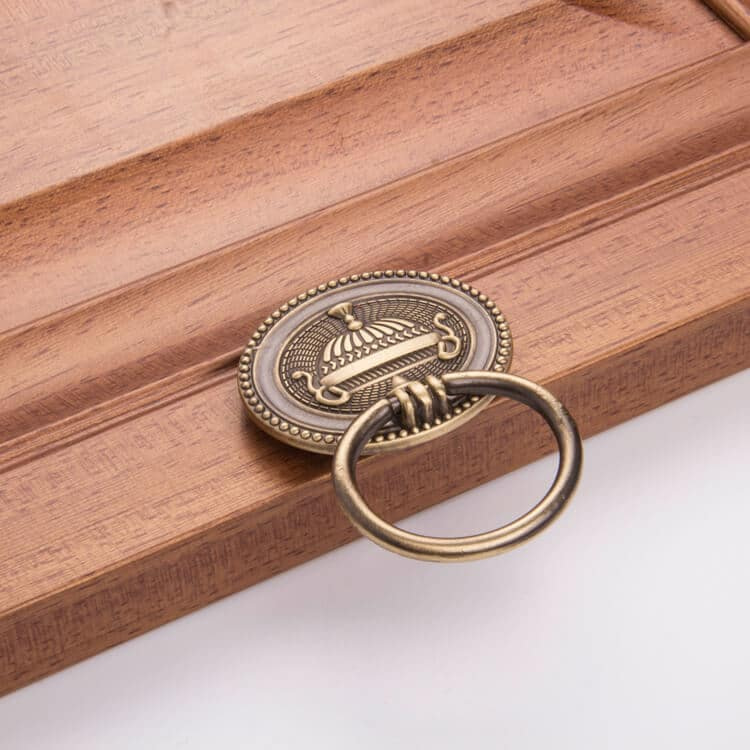Understanding how to date antique furniture hardware may help you discover more about the history and age of the antique furniture hardware you collect.
Hardware designs and manufacturing techniques have evolved throughout time, and antique furniture hardware is full of hints if you know where to look.
Checking the form and quality of the furniture screws, nails, as well as the wood and surface, may give you a decent indication of when and perhaps who constructed the furniture.
If you are one of the antique collectors and are just beginning to collect vintage furniture, this article is for you!
We will provide practical tips on how you can date and check your antique furniture hardware!

1. Be familiar with the style of the furniture hardware
2. Assess the top, bottoms, and backs of the furniture
3. Figure out what tools were utilized
4. Check matching materials and elements
5. Evaluate the wood and upholstery materials
6. Check the screws and other antique furniture hardware used
1. Be familiar with the style of the furniture hardware

When attempting to identify the age of the furniture, you cannot just glance at the furniture design.
Over the years, popular designs have been frequently replicated, and some of these classic types are being manufactured by countless furniture hardware suppliers today.
Once you’ve decided on a style, check for indications of age that will tell you if you’re dealing with an antique or not.
Here are some of the recognized styles of antique furniture hardware way back:
1-1. Chippendale
Chippendale antique furniture hardware is an American style that dates back to the 16th century. It is distinguished primarily by the style of the feet and legs and is often made of dark wood.
The Chippendale style has withstood the test of time, being a staple of interior decoration since its beginnings.
Important Chippendale pieces may sell for millions of dollars, but this design has been resurrected many times since the 1700s and can be found in a variety of price levels.
The best Chippendale style pieces were typically constructed of mahogany, although other woods, such as walnut, cherry, and maple, were also used to make more inexpensive Chippendale style furniture.
Later variants often combine a variety of woods and, in general, have a dark finish to resemble antique pieces.
1-2. Queen Anne
Queen Anne furniture is lighter and less bulky in look than the previous furniture, indicating a shift in style in the early 1700s.
The furniture of the Queen Anne style dating from the 1720s to about 1750 in England, despite the fact that the monarch it is named for died in 1714.
Production in the United States lasted longer, until about 1800. This ever-popular design is associated with the Colonial era.
Queen Anne-style items were the first to use the curved cabriole leg, signaling a move toward beauty and elegance in furniture manufacturing.
Most items, including pedestal accent tables and bed frames, had cabriole-shaped legs, although on a smaller scale than those seen on chairs and tables.
Queen Anne’s influence may still be seen in formal furniture design and manufacture today, particularly in the usage of the ubiquitous cabriole legs and pad feet.
Many furniture hardware owners still seek their trusted sourcing company for Queen Anne’s style furniture.
They are often mixed with other style components to create one-of-a-kind, contemporary appearances with classic undertones.
1-3. Rococo revival
Rococo Revival works are often referred to as Louis XV or Louis XVI style, harkening back to the 1700s Rococo beginnings.
Rococo Revival ornamentation was mostly used on living room and bedroom furniture.
Sofas or settees in a range of designs, center and side tables with marble tops, and a variety of chair types with upholstered and open backs may all be found in parlor sets.
2. Assess the top, bottoms, and backs of the furniture
Check out the joinery. The joinery in furniture refers to the points where the components fit together.
Examine the bottom or rear of a piece, as well as the insides of its doors and furniture drawers.
This may offer vital information regarding whether an antique piece of furniture was mechanically cut or handcrafted.
Most handcrafted items will have surface imperfections, such as small nicks caused by the use of a hand plane to level out the wood.
These scratches are sometimes more visible on the rear than they are on the completed, front surface.
If the work seems to be too even or flawless, it was most likely machine-made or machine-cut.
3. Figure out what tools were utilized
When hand planes were used to smooth wood, they often left an uneven surface.
This is particularly noticeable on the back or underside of items produced before the mid-nineteenth century.
Cuts and nicks in the wood were left by hand chisels and wood-shaping tools used with elbow grease.
When round saws were used, a circular pattern was typically left behind as proof.
Manually powered hand saws, on the other hand, left a more straight pattern.
Handmade furniture hardware does not have the same historical significance as an antique item. Even now, furniture is still handcrafted.
Machine-made evidence, on the other hand, provides a clearer picture of where the furniture could not have come from.
4. Check matching materials and elements
Small matching components on furniture, such as wooden drawer knobs, seat spindles, or feet on various items, may have minor form variations.
This may imply that they were handmade before 1860.
Machine-made furnishings will have parts that are more precisely matched than hand-made furniture hardware.
Without the help of technology, it is almost difficult to produce the same precise furniture piece again and over again.
5. Evaluate the wood and upholstery materials
It may be difficult to identify the kind of wood or finish used on a piece of furniture, but these are significant indicators.
When additional characteristics like design and building methods are considered, you may obtain a better estimate of the piece’s age.
Various woods were popular throughout various furniture eras.
The kind of wood used is not a precise indication of age.
Traditional upholstery materials such as wool, silk, and cotton were produced and woven into a wide range of satins, and brocades with a wide range of designs.
Various materials and fabric patterns were popular for upholstery at various times.
6. Check the screws and other antique furniture hardware used
Examine the furniture screws carefully. Furniture screws were not fully machine-made until 1848.
So, if you come across antique furniture hardware with screws that have fully rounded shafts, pointy ends, and flawlessly polished heads with matching cuts, it is most likely from the mid-nineteenth century or later.
Furniture screws manufactured between approximately 1812 and the mid-1800s were partly machine-made, giving the thread a more even look.
However, the heads were still completed with hacksaws to insert the screwdriver groove, so no two are precisely identical.
Brass hardware went out of favor in furniture manufacturing from the 1830s until the Eastlake era in the 1880s, when it was seldom employed.
If you have a piece with brass, it is most likely pre-1830s or a late 1800s revival item.
You can always consult a reliable furniture hardware supplier to get to know more about screws.
6-1. 18th century and beyond
Prior to the early nineteenth century, most screws were handcrafted. You may notice variations in the size and form of screws used in furniture when using handcrafted screws.
The furniture screws will not be equal because the heads will be off-center and the slots on the heads will be off-center.
6-2. 19th century
During the mid-1800s, furniture materials suppliers often utilized machine-made screws that lacked a groove.
The slot had to be cut with a hacksaw by the furniture craftsman, and it was often off-center.
The body of the furniture screw is consistent throughout this period, although the slots vary in location.
Screws were produced partly by machine until about 1846.
These furniture screws will have a more consistent thread pattern, although the heads and slots may be off-center.
6-3. 1856 and later
The first fully machine-produced furniture screws were created in 1856.
Fully machine-made screws soon became the standard, and most furnishings from the late nineteenth century and later has uniform screws.
7. Takeaways
Assessing the age of antique furniture hardware is not a straightforward process, but there are certain obvious signs of age in furniture.
The way an item is built is a frequent indicator of its age.
Examine the screws, nails, hardwood, joining, and hardware. The form and quality of materials are utilized to determine a piece’s age.
A piece of furniture’s wear and tear may also be used to determine its age.
We hope our tips were able to help you out!







0 Comments